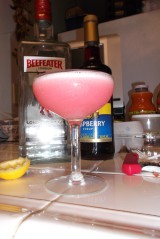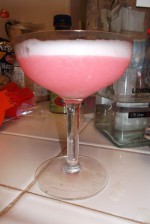Drink of the Week: The Commodore

One fact of boozy life that is both a source of endless fascination and constant befuddlement is that there isn’t a single cocktail recipe that is even remotely agreed upon, much less set in stone. Some may insist that an Old Fashioned is always made with exactly one teaspoon of water or club soda, one sugar cube, and two dashes of Angostura bitters. However, no one’s going to stop me from muddling an orange slice and/or cocktail cherry and maybe adding a bit more water and liking my version a bit better.
This week, I’m extra befuddled and feeling vaguely guilty. That’s not so much because of anything having to do with today’s drink but because this post is appearing just a few hours before the start of Yom Kippur and vague guilt is just a the natural state of being for ultra-secular Jews like myself.
Leaving all that tsuris aside, I can tell you that the Commodore is a worthwhile classic/pre-prohibition beverage with a softer edge, but I can’t even tell you which version I personally prefer. So, this week you get two recipes for the price of one, even if you’re really not supposed to be handling money on the high holidays. Did I mention that you’re also reading this on a Friday the 13th?
The Commodore
1 1/2 ounces bourbon
1 ounce fresh lemon juice
1 ounce white creme de cacao
1/4 teaspoon grenadine
OR
2 ounces bourbon
1/2 ounce fresh lemon juice
3/4 ounce white creme de cacao
1/4 teaspoon grenadine
Whichever recipe you choose, combine all the ingredients in a cocktail shaker, shake vigorously, and strain into a chilled champagne flute or cocktail glasses. Drink and toast our nation’s maritime armed forces or Dabney Coleman of “Boardwalk Empire.” (I’m at least two seasons behind so, please, no clues on the Commodore’s ultimate fate, please.)
*****
Allow me to explain the nature of this week’s cocktail cockup. Returning to the scene of the crime that was my recent Clover Club triology, my first try at the Commodore was a recipe taken almost exactly from Robert Hess’s The Essential Cocktail Guide, the second of the two recipes you see above. Made with Four Roses bourbon from a nearly empty bottle, it was pretty wonderful, with the chocolate from the creme de cacao doing a merry dance with the bourbon and citrius as the grenadine added just a hint of additional color. (The one change I made in Hess’s recipe is rendering his “dash” of grenadine as a quarter teaspoon.)
Subsequent research, however, provided me with two discoveries. Firstly, there are actually a number of barely related classic-era cocktails called “Commodore,” including one with rum and egg white I might well be trying pretty soon, and a version from The Savoy Cocktail Book that is basically just a super simple Canadian whiskey sour. Secondly, I discovered that the Hess recipe was actually a refinement of a somewhat less boozy cocktail from an era when good bourbon was probably a little harder to find than in these times of alcoholic plenty.
So, that led me to the first recipe of the cocktail you see above. While I found that I enjoyed it well enough, one of my in-house guinea pigs found it a bit over-citrusy and I had to admit it wasn’t quite the subtle taste treat I remembered from my first try at the Commodore. I found, however, that when I switched out the lighter 80 proof Four Roses I started with for some 100 proof Knob Creek, I liked that version a lot better. Still, that first drink, the one with more whiskey and less lemon, was so strong in my memory that it would still just have to my recommendation to the denizens of DOTW land.
That, however, went all to hell when I tried the Hess recipe again. A super-boozy attempt using two whole ounces of Knob Creek was, to my mouth, a bitter tasting non-starter which I tossed out. I then went with what I thought would be a sure thing — Basil Hayden, which is both 80 proof and an absolutely outstanding bourbon that usually mixes superbly. For whatever reason, using it with the Robert Hess recipe was okay but far from spectacular. Since I’m out of Four Roses, it’s hard to know whether my love of that first Commodore was just the thrill of the new, or a repeatable phenomenon, as long as I stuck with just the right bourbon. So, despite being a bit citrusy and overtart, I think I’ll have less to atone for, and will have a slightly better chance of being inscribed in the Cocktail Book of Life, if I steer readers towards the older recipe I listed first. Got that?
Shana tova, everybody.
You can follow us on Twitter and Facebook for content updates. Also, sign up for our email list for weekly updates and check us out on Google+ as well.

 It’s just about Labor Day weekend and today we have one cocktail that I’ve really labored over. In fact, if you’ve been paying very close attention, you’ve been following us through
It’s just about Labor Day weekend and today we have one cocktail that I’ve really labored over. In fact, if you’ve been paying very close attention, you’ve been following us through  If you have a deep aversion to déjà vu, I advise you to take a break from today’s and, yes, next week’s posts. (I haven’t decided yet about the week after that!)
If you have a deep aversion to déjà vu, I advise you to take a break from today’s and, yes, next week’s posts. (I haven’t decided yet about the week after that!) Sometimes the difference between one drink and another is miniscule. Take a
Sometimes the difference between one drink and another is miniscule. Take a 








